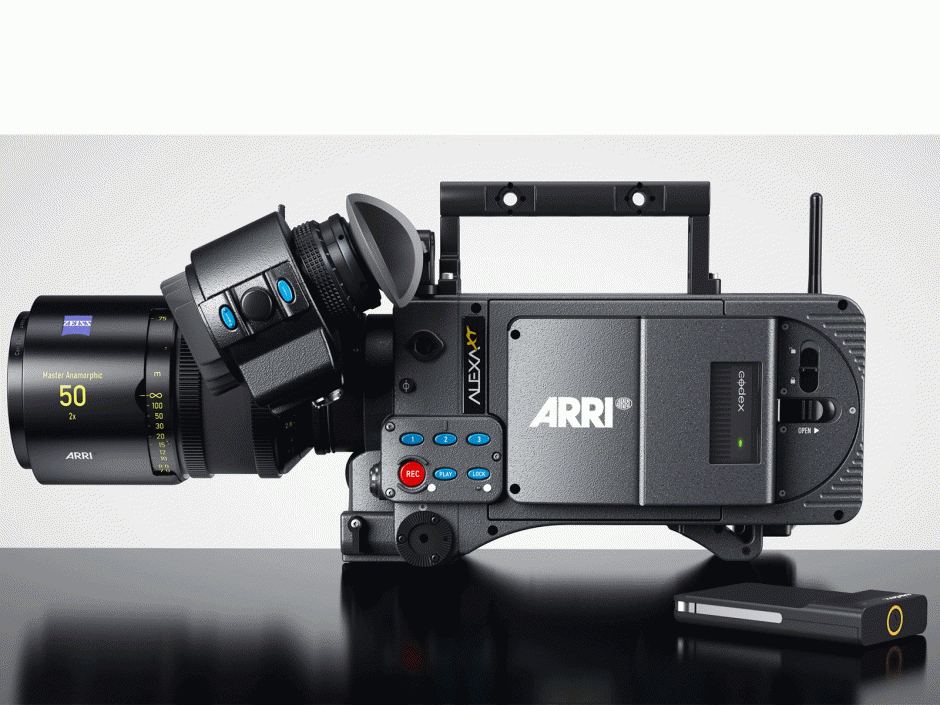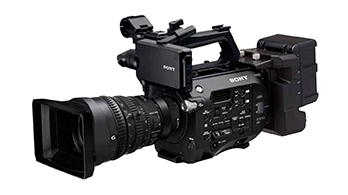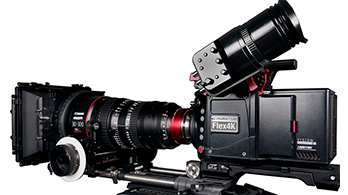Arri Alexa xt Features
The smallest and most affordable Alexa xt camera
While sharing all the features of the Alexa xt family like in-camera ARRIRAW recording, built in ND filtration, a 4:3 sensor, Open Gate sensor mode, the Lens Data System, integrated CDL capture, a new Viewfinder Mounting Bracket and a super-silent fan, the Alexa xt is the smallest and most affordable of the bunch. This camera is ideal for all those who do not require wireless remote control (ALEXA XT Plus), a separate head/body design (ALEXA M) or an optical viewfinder with a rotating mirror shutter (ALEXA Studio), but still need a camera that delivers exceptional image performance, efficient and versatile workflows, simple and safe operation and an open, future-proof architecture.
Alexa xt Family Features
Faster, lighter and more affordable ARRIRAW
All ALEXA XT cameras come with the new XR Module (Xtended Recording), a side panel that was co-developed with Codex to replace the previous SxS Module. The XR Module allows in-camera ARRIRAW recording up to 120 fps onto exceptionally fast and rugged 512 GB XR Capture Drives. This not only makes for a smaller, lighter and more affordable camera package, it also simplifies setup and operation while avoiding unnecessary cabling. The result is an even faster and more reliable way to record ARRIRAW, ALEXA’s highest quality image output.
Once removed from the camera, the XR Capture Drive offers a number of different paths into post for every budget and time schedule demand, using the proven Codex workflow. First, the small and affordable Single Dock USB3 allows safe copying of data to a Retina MacBook Pro. Second, the Dual Dock can make clones of XR Capture Drives and connect to a Mac Pro via SAS (Serial Attached SCSI) for high speed copying. The included software provides all features for an efficient digital lab. And third, the Codex Vault is a modular, rugged and complete solution for copying, archiving, metadata management, reporting or dailies creation with the greatest ease and highest speed.

Faster and longer ProRes/DNxHD in-camera recording
In addition to ARRIRAW it is also possible to capture ProRes or DNxHD to an XR Capture Drive for significantly longer recording times as well as ProRes 4444 recording at 120 fps. ProRes 4444 at 24 fps can be recorded for a total time of 107 minutes. And recording onto SxS PRO cards is also possible: with the SxS Adapter it is possible to record ProRes or DNxHD to a single SxS PRO card, thus protecting the inventory of existing cards. And with the CFast 2.0 Adapter it is possible to record onto CFast 2.0 cards, the same medium used by AMIRA, the new documentary style camera.
As an extra feature, the black protective top cover of the XR Module can be replaced with red, green, blue, yellow or white top covers to identify A, B, C, D, E and F camera units.

True anamorphic with a 4:3 sensor
For the most effective use of anamorphic lenses, each ALEXA XT model is equipped with a 4:3 sensor of the same size and shape as a Super 35 mm film frame. A 4:3 sensor is crucial for delivering the unique and cinematic widescreen look that can trace its origins back to the CinemaScope films of the 1950s. It is a look that has long been appreciated by cinematographers, directors and the viewing public. An anamorphic de-squeeze license is included with all ALEXA XT cameras, as is a high speed license for filming at up to 120 fps. The 4:3 sensor is also useful for non-anamorphic productions as it permits significant reframing of the image in post, similar to shooting 4-perforation 35 mm.

Record it all: Open Gate sensor mode
While 16:9 and 4:3 modes will remain the standard for most ALEXA capture, some specific situations will benefit greatly from recording in Open Gate mode, including wide angle establishing shots, image repositioning, resizing, rotating or stabilizing, native 3.4K VFX work, special venue projects or up-scaling to 4K.

High quality internal full-spectrum ND filters
The In-camera Filter Module IFM-1 for the first time offers neutral density (ND) filters that maintain a neutral color balance at all densities.

Click here to see the FSND spectral response graphs

Click here to see the FSND sample test images
Using internal ND filters allows a rating at the base sensitivity of EI 800 without the need for external ND filters, even in bright sunlight. Filtering behind the lens rather than in front saves time and reduces weight, reflections and complexity. In addition it decreases narcissism, which is an unwanted reflection between the last lens element and the sensor and protects the sensor from dirt contamination during lens changes.

The FSND (Full Spectrum Neutral Density) filters used with the IFM-1 are based on a number of high-tech manufacturing methods that are very different from common external filters. A spectacularly neutral color balance at all densities is achieved through a broadband absorptive coating that attenuates the full spectrum. To maintain a high contrast, an anti-reflective multi-coating reduces internal reflections. A sharp image is assured through a base of water-white optical glass that is precision polished to create perfectly parallel surfaces. While all ALEXA XT cameras come with the IFM filter holder installed, the FSND filters themselves are available separately in 8 densities from ND 0.3 to ND 2.4 plus an optical clear. Out of the box the ALEXA XT cameras can be used without a filter, and when FSND filters should be used, a IFM shim has to be installed in the lens mount.

More efficient VFX through lens metadata
Lens metadata is invaluable for efficient working on the set and for a speedy VFX post workflow, which is why all ALEXA XT models are equipped with an LDS lens mount and why all ALEXA XT models insert a plethora of metadata into all recording and output formats.
On the set, streaming lens metadata is used for an overlay in the ALEXA display, viewfinder or MON OUT image. In addition, it is used by the Wireless Compact Unit WCU-4 for an easy to use graphical lens display. At the same time, the HD-SDI image carries streaming lens metadata (as raw encoder pulses and as interpreted lens data) which can be displayed on some monitors or used for real-time virtual set applications.

Compositing in post is greatly sped up through the use of lens metadata carried inside the ARRIRAW, ProRes or DNxHD files. The lens metadata allows to automatically match the computer graphic images to the images taken with the real lens, a process that used to take a long time of manual tweaking. In the example below, a Lincoln car was inserted through computer graphics into an image that originally contained a stunt car. The lens metadata was used to exactly duplicate the focus, depth of field, perspective and minor distortions introduced by the real lens.

Over 42 ARRI lens models have LDS built-in, including the ARR/Zeiss Master Anamorphics, ARRI/Zeiss Master Primes, ARRI/Zeiss Master Macro 100, ARRI/Zeiss LDS Ultra Primes, ARRI Ultra Wide Zoom UWZ 9.5 – 18, ARRI/Zeiss Master Zoom 16.5-110, ARRI/Fujinon Alura Lightweight Zoom 15.5-45 and ARRI/Fujinon Alura Lightweight Zoom 30-80. The ARRI LDS also includes support for the Cooke /i system. For all other lenses it is possible to gather lens metadata by using an ARRI lens motor and a lens table stored in the camera (Lens Data Archive).

Safely carry CDL color correction metadata into post
An increasing number of productions are setting up on-set color correction systems so the cinematographer can create and monitor a pre-grade of the footage. When shooting ARRIRAW, the resulting ASC CDL (American Society of Cinematographers Color Decision List) can be automatically transferred to the ALEXA XT cameras and stored as metadata for fast and convenient retrieval in post.

Viewfinder Mounting Bracket VMB-3
To provide maximum comfort for the operator, the new Viewfinder Mounting Bracket VMB-3 has a much stronger and more rigid design, partially achieved through the use of two 15 mm lightweight rods. These rods also facilitate rapid changes in camera support, i.e. from a tripod to a crane or Steadicam, since accessories such as lens motors or follow focus units can be hung from them rather than cluttering up the base plate. A special anodizing process is used on all moving parts for a very hard yet low-friction surface and a bubble level allows for speedy leveling of the camera.
Also available as a separate accessory is the new Viewfinder Extension Bracket VEB-3, with a more sturdy design and a fold-out arm that holds the viewfinder securely in place when moving the camera.

 Super Silent ALEXA XT Fan
Super Silent ALEXA XT Fan
ALEXA cameras are already among the quietest digital cameras, but an even quieter fan has become available and ARRI has incorporated this new fan into the ALEXA XT models, providing an extra safety margin in very quiet or hot environments. The new fan can be identified by an orange dot on top.
ALEXA Classic and Alexa xt Family Features
Exceptional Image Performance
All ALEXA cameras provide the best looking digital image with the least amount of fuss. They all have the same high end optical low pass filter, a custom made CMOS sensor, electronics and processing software. These components are carefully designed to produce images with the organic look and feel of film.

The ALEXA sensor provides an unequalled exposure latitude of more than 14 stops with special consideration given to highlight treatment. Creating a good looking roll-off in the highlights is probably one of the most difficult tasks for any sensor designer and we have spent enormous resources at insuring exceptional highlight handling. ALEXA’s wide exposure latitude translates into a ‘thick’ digital negative; there is more detail information in the highlights and in the dark areas than any of the current display technologies can disclose. This translates into tremendous flexibility when color grading and makes ALEXA images future proof for high dynamic range display technologies.

Click here to see an illustration of ALEXA’s exposure latitude
ALEXA’s high sensitivity and its ability to retain definition even when extremely under or overexposed make it very easy to work with. ALEXA’s color processing was developed by our own color scientists, who are the same people that have been working on the ARRILASER and ARRISCAN, so are intimately familiar with both film and digital color science. ALEXA renders clean and natural colors, especially noticeable in ALEXAs great looking skin tones and its ability to resolve mixed color temperature sources.
Efficient and Versatile Workflows
ALEXA represents the most efficient and versatile method to capture and then transport images, audio and metadata through the production process. This is achieved with a multitude of output options, support for the native codecs of the most popular non-linear editors, complete metadata, integrated color management and a pre-recording option. So disregarding if you want to shoot a low budget TV series or Martin Scorsese’s next big Hollywood feature, you can configure an ALEXA for the task at hand. This also make rentals happy, who can use the same product for many different customer demands.

Simple and Safe Operation
 We know what it is like to try to change frame rate and shutter angle at 4:00 in the morning in the rain after a long night shoot. We know that a camera needs to be very simple to operate, and it needs to make sure that you get a good image, no matter what. With ALEXA we have developed a user interface that is easy to learn and quick to operate. The same interface is used on all ALEXAs, with the same menu, buttons, etc., so there is no learning curve when using another model ALEXA. The hardware of the camera is designed for the best and most ergonomic use on the set, including the built-in shoulder cut-out, large numbers of accessories like the Low Mode Support LMS-3, the Remote Control Unit RCU-4 or the Wireless Compact Unit WCU-4, down to little details like differently shaped extrusions (eyebrows) above some buttons so the operator can feel the button’s position even from the other side of the camera or when shooting in low light.
We know what it is like to try to change frame rate and shutter angle at 4:00 in the morning in the rain after a long night shoot. We know that a camera needs to be very simple to operate, and it needs to make sure that you get a good image, no matter what. With ALEXA we have developed a user interface that is easy to learn and quick to operate. The same interface is used on all ALEXAs, with the same menu, buttons, etc., so there is no learning curve when using another model ALEXA. The hardware of the camera is designed for the best and most ergonomic use on the set, including the built-in shoulder cut-out, large numbers of accessories like the Low Mode Support LMS-3, the Remote Control Unit RCU-4 or the Wireless Compact Unit WCU-4, down to little details like differently shaped extrusions (eyebrows) above some buttons so the operator can feel the button’s position even from the other side of the camera or when shooting in low light.
ALEXA cameras are part of a long heritage of cameras from ARRI, and we are very familiar with the sometimes horrid conditions our cameras have to endure in the field. So ALEXAs are built rugged and reliable with a sealed electronics compartment, a unique cooling system and the most stable lens/sensor mount that German engineering could devise.
The camera’s electronics are housed in a sealed compartment in the center of the body. The heat generated by the sensor and the electronics is transported via heat pipes to a radiator located in a ventilation shaft at the back of the camera. A single, slow running silent fan cools the radiator. If need be, the fan can be easily exchanged. This system ensures effective, active cooling of the sensor and processing boards even in the hottest climates. At the same time it protects the electronics, thereby rendering the camera splash and dust proof.

To further improve the legendary stability of the ARRI lens mount, ALEXA is equipped with a novel lens and sensor mount design. The stainless steel lens mount is attached to a stainless steel distance barrel, which itself is attached to the sensor mount, which also holds the sensor board. The whole unit is then attached to the camera body. By creating a fixed link between lens and sensor (all the orange parts in the second drawing), a super stable flange focal depth is ensured – even if strong mechanical influences are applied to the lens mount, such as when a heavy zoom lens is not properly supported. Using stainless steel ensures minimum material expansion or contraction during temperature changes.

In order to protect against the vagaries of production, ALEXA will continuously close the file it is recording. In case of a power failure, your data is protected and the media will contain a readable, uncorrupted file. If a metadata file is damaged, on the next reboot ALEXA will look at the actually recorded frames and reconstruct the metadata accordingly so you can continue to record on that media; we call that ‘self-healing metadata’.
Open, future-proof architecture
 We have worked closely with a number of innovative companies such as Apple, Avid, FUJINON, ZEISS and others to integrate their technologies. Thus ALEXA is compatible with many existing industry standards and with lenses, accessories and post production tools that are already well established all over the world, including Apple’s ProRes, Avid’s DNxHD, the HD-SDI standard, Gold or V-mount on-board batteries, the cmotion lens control system and both 12 and 24V accessory power outputs. The result is a future-proof system based on an open architecture; the result is simply the most complete and powerful digital production system ever built.
We have worked closely with a number of innovative companies such as Apple, Avid, FUJINON, ZEISS and others to integrate their technologies. Thus ALEXA is compatible with many existing industry standards and with lenses, accessories and post production tools that are already well established all over the world, including Apple’s ProRes, Avid’s DNxHD, the HD-SDI standard, Gold or V-mount on-board batteries, the cmotion lens control system and both 12 and 24V accessory power outputs. The result is a future-proof system based on an open architecture; the result is simply the most complete and powerful digital production system ever built.
To protect our customers’ investment in ALEXA, four major components are specifically designed to allow an easy upgrade and to add new features in order to extend its useful life. First, taking into account the rapid rate of change in storage technologies, the in-camera recording module is removable, featuring an SxS Module for ALEXA Classic cameras (which can be exchanged for an XR Module) or an XR Module for ALEXA XT cameras. Second, the camera control electronics, which comprise the whole right side of the camera, can be removed and replaced with an upgraded electronics with advanced features (like the Plus upgrade). Third, the Exchangeable Lens Mount (ELM) system allows the use of PL or Panavision lenses, further expanding creative options. And finally, the camera’s powerful processing hardware is based on FPGAs, a technology that allows a complete re-programming of the hardware (in contrast to cameras based on ASICs). Thus ALEXAs can be quickly and easily upgraded with our free Software Upgrade Packets to provide new and exiting features like ProRes 2K or ProRes 4:3 in-camera recording.
ALEXA Electronic Viewfinder EVF-1
 This viewfinder was specifically designed to meet the needs of professional camera operators by offering an extremely low latency image display, high image quality, accurate color reproduction and a number of features inherited from our optical viewfinders, including a peripheral viewing area (surround view).
This viewfinder was specifically designed to meet the needs of professional camera operators by offering an extremely low latency image display, high image quality, accurate color reproduction and a number of features inherited from our optical viewfinders, including a peripheral viewing area (surround view).
It is critical to the camera operator that the action in the viewfinder can be seen almost at the same time as the action in front of the camera. The extremely fast image display of the EVF-1 has been made possible through the creation of a proprietary high speed connection between the viewfinder and the camera, as well as a shared image processing architecture that maximizes the processing power of both camera and viewfinder. The ALEXA EVF-1 is unique and uniquely suited for work on the set with its image delay of under one frame.
A stable, accurate and high quality image is important for the camera operator. The EVF-1 image exhibits high resolution, high contrast, low distortion and an evenly illuminated viewing area. All this has been made possible through a state-of-the-art F-LCOS (Ferroelectric Liquid Crystal On Silicon) micro display with 1280 x 768 pixel resolution, a high screen refresh rate and an ARRI optical design that employs the highest quality coated glass elements. Reliable contrast and color reproduction at all temperatures are assured through careful thermal stabilization of both the FLCOS display and the ARRI custom LED light engine.

The EVF-1 has not only been developed to provide the best possible image, but is also specifically designed to fit the ergonomic needs of the operator. Even when using a matte box on a short prime lens, the compact dimensions of the finder guarantee that the eyepiece can be adjusted to a comfortable position for shoulder operation. The small, self-contained unit is easily mounted in different positions: on the left side for handheld, on the right side when the set is tight or further back through a telescoping extension for use with a geared head.
Straightforward operation is assured through a plethora of assistive displays in the viewfinder (and on the MON OUT as well), including: preset and custom frame lines, user rectangles, surround view, camera status, false color exposure check, peaking focus check, compare stored image with live image, RETURN IN video and an optional anamorphic de-squeeze (license key required on some ALEXA Classic cameras). A number of ergonomically placed buttons allow convenient access to frequently used functions such as zoom and false color exposure check. The viewfinder’s settings, as well as the basic camera settings, can be changed by the operator directly on the EVF-1.
Showing their heritage, ALEXA and the EVF-1 have been designed to provide some features that previously have only been available through optical viewfinders. Most important for the operator is the fact that the camera’s sensor is slightly oversized to provide an extra area around the primary image in the viewfinder (Surround View). This allows lighting stands, microphones, etc. to be spotted before ruining the shot. Additionally, the size of the image in the EVF-1 has been chosen to equal that of the image in the optical viewfinders of ARRIs range of film cameras.























